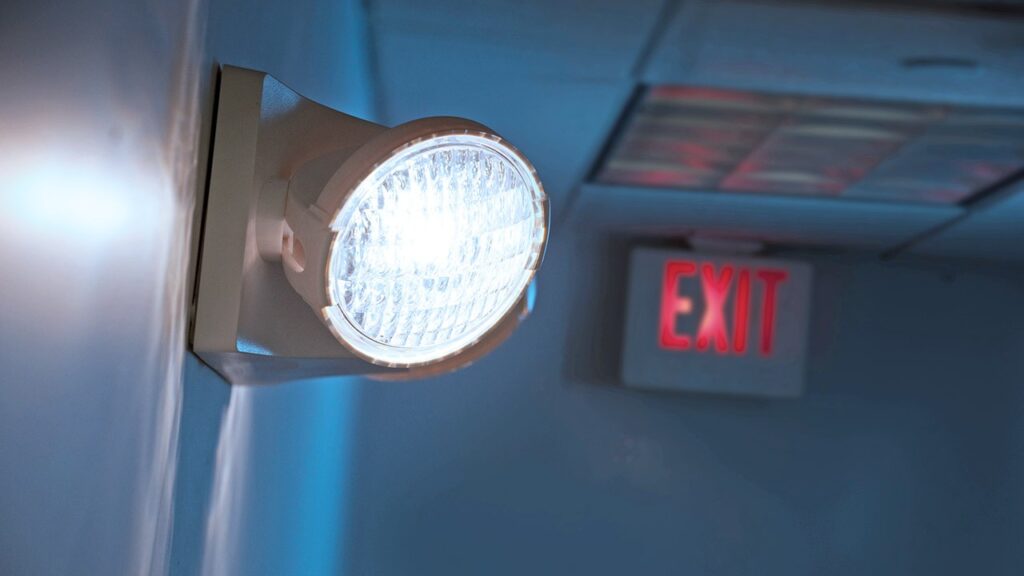In our daily life, lighting is one of the most common elements we come into contact with. However, in the event of an unexpected power outage or other emergency, ordinary lighting equipment will be useless. Emergency lighting equipment can play an important role in such situations, providing sufficient light sources for people to help them evacuate or shelter smoothly.
How to choose the right emergency lighting equipment? Choosing the right emergency lighting equipment is not only a matter of safety, but also has a direct impact on the efficiency of evacuation and the safety of personnel. In order to ensure that a building can function properly in any emergency situation, the selection of emergency lighting equipment must take into account a number of aspects, including the type of equipment, regulatory requirements, duration, installation and maintenance, and other factors. This article will provide you with detailed answers on how to select and install the most suitable emergency lighting equipment from these perspectives.
Table of Contents
1. The importance of emergency lighting
In emergencies such as sudden power outages or natural disasters, the interruption of the lighting system can create a huge safety hazard. Especially in confined environments, darkness not only causes people to be unable to see the environment properly, but can also increase the risk of panic and confusion.

The role of emergency lighting equipment is to provide the necessary source of light in such situations. Above all, it ensures that in the event of a power outage or disaster, personnel have access to effective lighting in the shortest possible time, avoiding the chaos and panic caused by ambient darkness. Emergency lighting to help people clearly identify emergency exits, channels, to ensure the safe evacuation of the crowd, especially in crowded places, such as shopping malls, hospitals, subways, etc., the significance of emergency lighting is even more significant.
2. What types of emergency lighting equipment can be done?
When choosing emergency lighting equipment, it is very necessary to understand the different types of equipment. Each type of emergency lighting equipment has its specific function and role.
2.1 Emergency exit sign lighting
Emergency exit sign lighting is equipment that ensures that personnel can quickly find a safe exit in the event of a power failure or emergency. It is typically installed above or near an exit and displays the exit sign by means of a fluorescent or LED light. Emergency exit sign lighting typically requires high brightness, low power consumption, and a long duration.
2.2 Emergency Step Lighting

Emergency step lighting is mainly used to provide lighting for vertical passageways, such as stairs, to prevent people from falling or becoming disoriented due to the dimness of the stairs. These luminaires are usually installed on both sides of the stairs or on the steps, and should be able to work properly even in emergency situations.
2.3 Emergency Lights

Emergency lights are one of the most common types of emergency lighting equipment. They are usually designed with built-in batteries and can be automatically activated to provide light for a certain period of time in the event of a power failure. Emergency lights can be widely used in corridors, office areas, etc. to ensure that personnel can see their surroundings and evacuate safely.
2.4 Emergency Access Light

The function of emergency passageway lights is to illuminate the passageway to help personnel quickly recognize the direction of the passageway in the dark. This type of lighting equipment usually has a long period of continuous lighting ability and strong light irradiation range, which can provide personnel with a clear evacuation path in the shortest possible time.
2.5 What about rechargeable table lamps as emergency lighting equipment?

The choice of rechargeable desk lamps as emergency lighting equipment is gradually being emphasized. They are usually compact, portable and can be recharged to provide a source of light in an emergency. Although they may not last as long as professional emergency lights, rechargeable table lamps are still a very convenient emergency lighting tool for homes or small places.
3. Where should emergency lighting be installed?
3.1 Safety exit

Safety exit is the key area of emergency lighting configuration. According to fire safety regulations, all safety exits must have effective emergency lighting and ensure that it is automatically turned on after a power failure. Emergency lighting luminaires are usually mounted on top of or to either side of evacuation signs to ensure that they are clearly visible in the dark and provide clear direction to personnel.
3.2 Passageways
Lighting systems in passageways are also critical. To avoid panic in an emergency, they should be illuminated continuously and evenly, avoiding ‘dark corners’ or obscured areas.

3.3 Stairways
Due to the confined nature of the space, it is important to ensure that every corner is adequately illuminated when installing emergency lighting in stairways.
3.4 Underground garages

In underground garages, the configuration of the emergency lighting system needs to pay more attention to the durability and strength of the light source, because there is usually no natural light in this kind of place, and the darkness will exacerbate the chaos in the event of fire or other emergencies. Therefore, not only the number of emergency lighting fixtures should be ensured, but also the brightness and duration of the fixtures should be reasonably configured to ensure adequate lighting.
4. The need to comply with local lighting regulations
International emergency lighting standards are mainly concerned with ensuring the safe evacuation of people in buildings in the event of power failure. Different countries and regions have their own regulations and standards, but the more widely recognized international standards include the following:
4.1 International Emergency Lighting Standards
- ISO 30061 – Requirements for the Installation and Testing of Emergency Lighting Systems in Buildings
This is a standard issued by the International Organization for Standardization (ISO) that specifies the design, installation, testing and maintenance requirements for emergency lighting systems. It mainly includes the light source requirements, installation location, light intensity and testing frequency of emergency lighting fixtures. - IEC 60598-2-22 – Luminaires, Part 2: Particular Requirements, Emergency Luminaires and Emergency Luminaire Systems
Issued by the International Electrotechnical Commission (IEC) for the design and safety requirements for emergency luminaires, including battery performance, operating hours, and light intensity that should be maintained in an emergency.
4.2 Local Lighting Codes
- NFPA 101 (USA) – Life Safety Code
This is a standard issued by the National Fire Protection Association (NFPA) that focuses on safety lighting requirements for buildings in the event of an emergency, including the need for emergency lighting systems to be able to operate for a minimum of 90 minutes in the event of a power outage and to ensure that the lighting is sufficient to direct the safe evacuation of people.
Key requirements for emergency lighting include:
- Light intensity: Emergency lighting should ensure that areas such as evacuation routes, exits and stairways are illuminated to ensure that the light intensity is sufficient to guide evacuation.
- Duration: Most standards require emergency lighting systems to operate for at least 90 minutes after a power failure.
- Automatic switching: Emergency lighting needs to turn on automatically in the event of a power failure of conventional lighting.
- Testing and Maintenance: The system should be periodically self-tested, manually tested or simulated to ensure proper operation.
5. Emergency equipment maintenance requirements
5.1 Regular Inspection and Replacement of Batteries
In order to ensure the effectiveness and reliability of the emergency lighting system, regular inspection and maintenance is essential. Battery is one of the most critical components of emergency lighting equipment, its battery life is usually between 3-5 years, beyond this time, the performance of the battery may decay, so it needs to be replaced regularly.

5.2 Luminaire cleaning and dustproof requirements
In dusty environments such as industrial areas and warehouses, the accumulation of dust may lead to heat generation or insufficient light output of the lamps, so regular cleaning and maintenance of the lamps is necessary to maintain the performance of emergency lighting.
5.3 Regular testing and calibration
Regular performance testing and calibration is necessary to ensure that emergency lighting equipment is able to function properly in emergency situations. This includes checking the light intensity of luminaires, battery level and automatic start function. Early detection and treatment of equipment failure can effectively avoid accidents.
6. Installation requirements for emergency lighting
6.1 Installation location and height requirements of lighting equipment
The installation height and location of emergency lighting equipment need to meet specific standards. For example, emergency exit signs and passageway lights should be installed in a conspicuous position, usually between 2.5 and 3 meters above the ground, to ensure that they are visible to everyone passing by.

6.2 Power Connections and Safety Considerations
The power supply of emergency lighting equipment should be connected independently from the main power supply of the building to avoid the lighting system not working even when the main power supply is cut off. In addition, special attention needs to be paid to electrical safety during wiring and installation to ensure that the system is not damaged and is resistant to interference.
7. Conclusion
The installation of emergency lighting equipment is not only a legal requirement, but also an important measure to ensure the safety of personnel. When selecting, installing and maintaining emergency lighting equipment, we need to consider a number of factors, including the size of the building, its use, regulatory requirements and the duration of the equipment. Only through proper design and maintenance can we ensure that in an emergency, we can provide reliable lighting to guide the evacuation
of personnel and reduce the occurrence of safety accidents.




